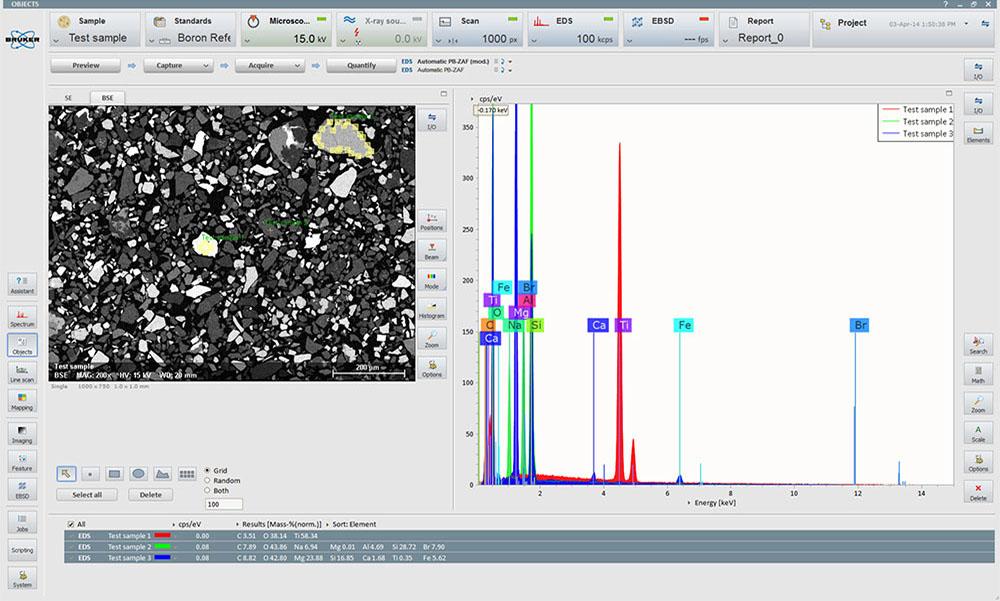Bruker EDS & EBSD

Adding Bruker EDS to your SEM turns it into a powerful analytical tool allowing a multitude of capabilities using advanced microanalysis features for elemental analysis. With the most optimal take-off angle of any Tabletop SEM, the EDS signal is collected at an optimum solid angle.
The Bruker ESPRIT Compact software provides many capabilities for probing the samples composition, thickness, and mapping as shown in the screenshots and explanations below.
- High speed embedded type SDD Dectector (No LN2 required)
- Energy resolution: Less than 129 eV (at Mn Ka)
- Detector area: 30mm
- Element detection range: B(5) – Am(95)
- Maximum input count rate: > 150 kcps
- Software: Qualitative or Quantitative Analysis
- Analysis Modes: Point, Circle, Polygon, Line Scan, Mapping

Point / Area Composition
- The software has easy-to-use features for Composition Analysis at Points, Rectangles, Circles, and Polygons
- Fast and accurate qualitative or quantitative analysis with calibration capability is standard
- Enhanced Deconvolution capabilities improve quantified results

Mapping
- Fast and high-resolution mapping analysis with Bruker’s Hyper Map
- Mapping provides the function of analyzing the distribution of elements
- Maps of individual element distribution can be broken out and saved separately
- Spectra for each pixel are saved in a database for later recall and manipulation of point or line scan analysis
- Various user settings for saving formats, colors, depth, filters, and more

Line Scan
- Draw ROI (region of interest) with a line and analyze elements along that line
- Easy to compare the elemental difference along ROI with line profile graph
- Very useful for cross-section thickness analysis of multi-layer samples including the mixing zone
- Various user settings for saving formats, colors, line scan width, filters and more

Reporting
- A variety of reporting formats are provided that can be edited as desired
- One-click saving of reports in Word or PDF
EBSD system was designed with the goal of accelerating the pace of progress in science and technology by enabling the large community of entry-level SEM users in academic research and industry to benefit from the power of EDS and EBSD techniques. To achieve this goal, Bruker has developed e-Flash XS, the most reliable and most affordable EBSD detector ever commercialized.
- CMOS imaging chip technology
- Native image resolution: 720 x 540 pixels
- Supported binning modes: 2x2, 3x3, 4x4, 5x5, 6x6
- Speed: up to 520 frames/second (fps) in all binning modes
- Custom made optics system with field lens for maximized light efficiency
- User-removable detector head with slide in & out mechanism
- User-replaceable phosphor screen
- True plug and play (PnP) device - data and power transfer via USB3.0 cable
- Outer dimensions: length ~ 84 mm (3.3 in), diameter ~ 48 mm (1.9 in)
- Weight: 850 g
Affordable
- Low initial investment cost
- Low cost of ownership: high-reliability hardware
and Field Replaceable Units (FRU) for low
downtime in the unlikely case of detector failure - Attractive service contract options
Powerful
- Full-featured ESPRIT 2 software suite with future
expansion capabilities ensuring full analytical power - Easy-to-use integrated EDS & EBSD
- Binning capable CMOS EBSD camera combines
the best of CMOS and CCD
Dependable
- Optimized use of lab resources:
– Run routine analyses to relieve backlog
on expensive FE-SEMs
– New users can be trained and practice EDS &
EBSD with less time constraints
– Check sample preparation quality before an
EBSD session on an FE-SEM
- No calibration required – ESPRIT 2 software is automatically correcting the pattern center coordinates for any changes in WD between various samples.
- Automatic camera gain optimization – quick and reliable feature for acquiring patterns with optimum signal-to-noise ratio.
- Automatic crystal phase setup – no user intervention required for setting the number of reflectors needed to achieve pattern indexing quality.
- Automatic data saving and EHT shutdown – EDS HyperMaps and EBSD maps can be automatically saved at the end of a map acquisition task following user defined preferences. The EHT can also be shut off automatically to save filament lifetime.
- No risks of accidental EBSD detector insertion into the SEM stage. e-Flash XS is using a unique functioning principle which allows the easy removal of the detector head to free-up the SEM chamber for non-EBSD related applications.
- User-replaceable phosphor screen.
Learn More About EDS
Recent Posts